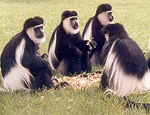Other Monkeys We Saw
Click here for the Blue Monkey.
Click here for the Red-Tailed Monkey.
Click here for the Vervet Monkey.
BLACK-AND-WHITE COLOBUS

How to Recognize
Black-and-white colobus are entirely black with long, white frills on their flanks and completely white or white-tipped tails. They have a black Ďmatadorís hatí and a white brow and beard that surrounds their naked, sad black face. The name colobus derives from a word meaning "mutilated one" because unlike other monkeys, they don't have thumbs.
Habitat
They can be found in rainforests and well-watered savannas. They live almost entirely in the trees, taking water from hollows on the branches.
Behavior
Diurnal. They live in small family groups of six to ten that are very sociable. These groups combine into troops of up to 25 individuals. Only the dominant male displays and mates, although the oldest female mostly leads the troop.
They maintain a limited home territory, making them easy to find. But they can be hard to actually observe as they normally spend their time high up in trees. Some 115 to 130 feet above the ground, they blend in well with their surroundings.
Traveling among the trees, they use branches as trampolines, jumping up and down on them to get liftoff for leaps of up to 50 feet. They rise up and then drop downward, falling with outstretched arms and legs until they reach another branch. Their mantle hair and tails are believed to act as a parachute during these long leaps.
When they do climb down to the ground, itís headfirst. They communicate with a songlike call, a warning call, and a mating call. Local tradition says they are good weather forecasters because they become silent when bad weather is coming.
In the early morning, troops of colobus sun themselves high up in a favorite tree. From here they can see neighboring troops. They demonstrate to these neighbors their troopís size and prowess by flaunting their tails and capes and occasionally shaking branches.
The dominant male in each troop periodically lets loose a chorus of raucous roars that echoes throughout the valley for 1Ĺ miles. The male has good reason to show his strength, as bachelor troops are watching and waiting for an opportunity to displace him and take over his harem.
Breeding
A single infant is born during the rainy season after a six-month gestation. They are born white, turning black at three to four months. The games the young colobus play exercise their bodies, and as they get older, these develop into wrestling matches and mock displays. At ten months, they become independent.
Feeding
They are strictly vegetarians, eating a very wide variety of leaves. Their complex digestive system allows them to eat old and fibrous leaves. They also eat unripe fruits and seeds.
They may consume up to a third of their body weight daily, but they must rest for long periods to digest. They usually feed in the morning and evening, and spend the afternoon sleeping and grooming. They groom each other, as well as themselves, paying particular attention to the long fluffy tail.
Enemies
At one time these monkeys were hunted excessively for their beautiful fur, leading to their extermination in some areas. Their skins have been used to make dance costumes, hats, and capes since early times. Today, the greatest threat to their continued existence comes from loss of habitat when forests are cut down.
TOP OF PAGE
Copyright © 2002, Dawn M. Dalton.
All rights reserved.
**LINKS**
WHERE?
WHY?
ITINERARY
PLAN YOUR TRIP
GETTING THERE
LONDON
KENYA
UGANDA
SAFETY
ITEMS BOUGHT
STAYING HEALTHY
COMMENTS
HOME
BHS HOME
---Animal Facts--
Baboon
Buffalo
Cheetah
Chimpanzee
Crocodile
Eland
Elephant
Gazelle
Giant Forest Hog
Giraffe
Gorilla
Hippopotamus
Hyena
Hyrax
Impala
Jackal
Lion
Mongoose
Monkey
Ostrich
Rhinoceros
Topi
Uganda Kob
Warthog
Waterbuck
Wildebeest
Zebra